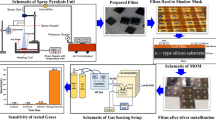2
O3, AlN and Si substrates produced by vacuum ultraviolet induced decomposition of palladium acetate is described. The palladium films formed and the palladium acetate layers used were characterised by using ultraviolet spectrophotometry and Fourier transform infrared (FTIR) spectroscopy. The optical transmission of the films after irradiation with pseudo-continuous 126 nm radiation generated by an excimer lamp provided information about the decomposition rate at different pressures and exposure times. The FTIR spectra recorded the chemical changes of the C=O, COO- and CH3 groups at different exposure times. The decomposition mechanism of the palladium acetate under these conditions appears to be quite different to that induced by pulsed laser irradiation.
Similar content being viewed by others
Author information
Authors and Affiliations
Additional information
Received: 25 November 1996/Accepted: 1 July 1997
Rights and permissions
About this article
Cite this article
Zhang, J., Boyd, I. Photo-decomposition of thin palladium acetate films with 126 nm radiation . Appl Phys A 65, 379–382 (1997). https://doi.org/10.1007/s003390050595
Issue Date:
DOI: https://doi.org/10.1007/s003390050595




